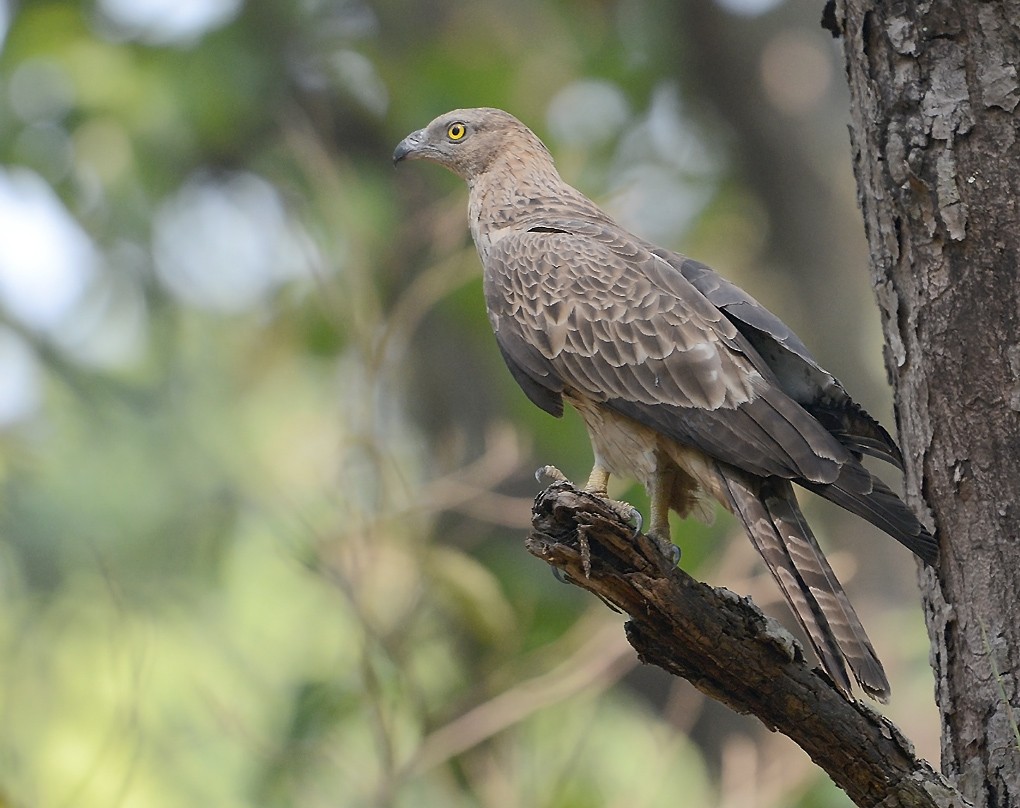Oriental Honey-buzzard
A species of Typical Honey-buzzards Scientific name : Pernis ptilorhynchus Genus : Typical Honey-buzzards
Oriental Honey-buzzard, A species of Typical Honey-buzzards
Botanical name: Pernis ptilorhynchus
Genus: Typical Honey-buzzards
Content
Description People often ask General Info
Description
Despite its name, this species is not related to Buteo buzzards, and is taxonomically closer to the kites. It appears long-necked with a small head (resembling that of a pigeon), and soars on flat wings. The head lacks a strong superciliary ridge, giving it a facial appearance very unlike a raptor. It has a long tail and a short head crest. It is brown above, but not as dark as European honey buzzard, and paler below. A dark throat stripe is present. Unusually for a large bird of prey, the sexes can be distinguished. The male has a blue-grey head, while the female's head is brown. She is slightly larger and darker than the male. The male has a black tail with a white band. It breeds in Asia from central Siberia east to Japan. It is a summer migrant to Siberia, wintering in tropical Southeast Asia. Elsewhere, it is more-or-less resident. It is a specialist feeder, living mainly on the larvae of social bees and wasps, and eating bits of comb and honey; it takes other small insect prey such as cicadas. The crested honey buzzard breeds in woodland, and is inconspicuous except in the spring, when the mating display includes wing-clapping. The display of roller-coasting in flight and fluttering wings at the peak of the ascent are characteristic of the genus Pernis. It is larger and longer-winged than its western counterpart, the European honey buzzard, Pernis apivorus. 
Size
68 cm
Colors
Brown
Black
Gray
White
Nest Placement
Tree
Feeding Habits
Oriental Honey-buzzard primarily feeds on social bees, wasps, and hornets, including their combs, larvae, and pupae. It also consumes insects, reptiles, frogs, small mammals, and occasionally preys on young or injured birds. Its feeding behavior showcases unique adaptations for raiding nests and consuming a variety of prey.
Habitat
Oriental Honey-buzzard favors a broad range of wooded habitats including tropical rainforests, broadleaf and mixed forests, and open woodlands. These birds can also adapt to fragmented forests and small groves in closer proximity to human settlements, including cultivated areas and Eucalyptus plantations. Geographically, oriental Honey-buzzard inhabits extensive bioclimates across tropical regions, being found in lowlands, hills, and mountain slopes. While typically residing at elevations up to 2000 m, oriental Honey-buzzard has been observed at altitudes of 3000 m or higher during migration periods.
Dite type
Omnivorous
People often ask
General Info
Feeding Habits
Bird food type
Species Status
Not globally threatened.
Scientific Classification
Phylum
Chordates Class
Birds Family
Hawks Genus
Typical Honey-buzzards Species
Oriental Honey-buzzard 